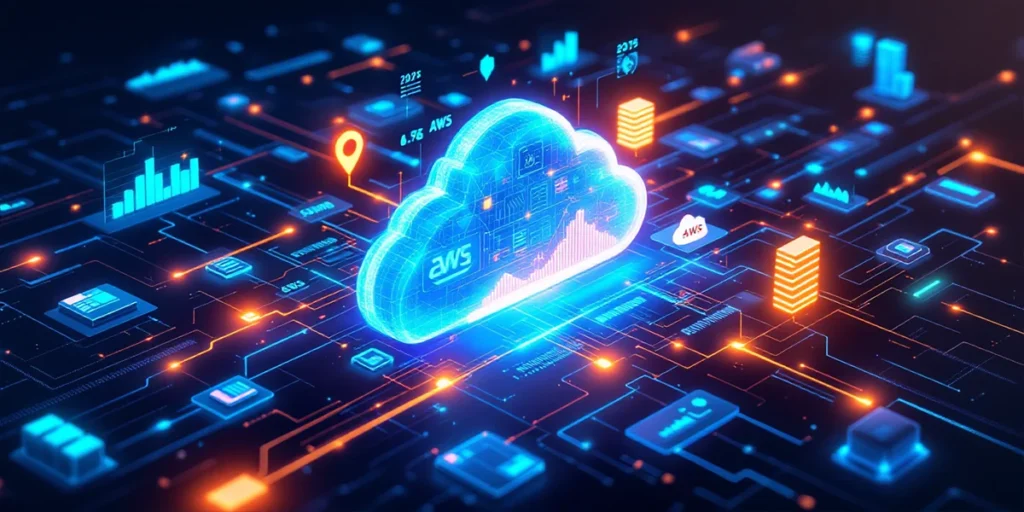
Modern cloud environments are ethereal as the skies they’re named after. They are delicate and ever shifting, which is why cloud management is harder than ever. Businesses constantly keep scaling and upgrading cloud infrastructure to meet their dynamic needs.
Therefore, it is no surprise that sometimes security gaps, inefficiencies, and performance issues can slip through cloud division teams. Amazon introduced AWS Monitoring to resolve this issue in its web services. Since most of their customers were small businesses, they realized they couldn’t build in-house tools to monitor and analyze their AWS environment.
AWS Monitoring is like the watchdog that keeps an eye on your cloud infrastructure without ever blinking. And in 2026, it can steer the direction of cloud management platforms towards a new era.
In this article, we’ll give an overview of AWS Monitoring and prove to you why the platform is so important to the future of cloud management.
What is a cloud management platform?
A cloud management platform (CMP) is a software product that a company can use to monitor, manage, and control its cloud environments. Whether some business is using a private, public, or hybrid cloud, CMPs act as a central command center for your cloud resources.
Cloud management emerged as a discipline around the late 2000s, after public cloud services like AWS, Azure, and Google Cloud Platform became mainstream. By that time, most businesses were using multiple clouds along with their on-premises systems. This created a “cloud sprawl” where hundreds of cloud services and accounts were scattered across providers.
AWS Monitoring and other cloud management platforms were created to solve this problem. CMPs commonly focus on hybrid and multi-cloud environments, so users don’t have to switch between provider tools.
Key features of a CMP
Cloud management platforms can include various offerings, depending on how advanced they are. But these are some of the common capabilities that most CMPs have:
1. Resource management
Cloud computing is done through different resources, such as virtual machines (VMs), networks, and containers. Cloud management solutions offer tools to automate the whole management process of these resources, from provisioning to orchestration.
Multi-cloud management platforms also help migrate these resources between different providers.
2. Service management
AWS has hundreds of cloud services. Managing all these services can become a rigmarole for IT teams. AWS Monitoring and other CMPs allow IT teams to monitor and manage cloud-based services with full visibility, which helps them to ensure the availability and performance of these services.
3. Security management
Hackers target cloud environments constantly. In 2019, there was a major cloud security breach at Capital One. CMPs offer cloud security management measures, like encryption, and tools like IAM to prevent attacks and keep a company’s cloud setup safe and secure.
Cloud security consulting companies also use these platforms to guide businesses on how to enforce consistent security policies.
4. Financial management
A major target of cloud management is to control the cloud spending of an organization. An enterprise’s cloud bill can quickly spiral out of control due to the complex nature of modern cloud environments.
Cloud management platforms utilize FinOps tools practices and features to track and allocate cloud spending in a cost-effective way.
What is AWS Monitoring?
AWS Monitoring is Amazon’s CMP for the AWS cloud environment. It includes cloud infrastructure management tools to track the health and performance of your entire AWS setup.
The CMP has tons of different tools that monitor and collect signals from different cloud resources to identify problems and fix them before they become a bigger issue. AWS Monitoring tools are divided into two main categories:
Built-in AWS tools that give you metrics, logs, and alerts about internal AWS resources. These tools or services include CloudWatch, CloudTrail, and AWS Config.
External third-party cloud management solutions that integrate with AWS to augment the CMP’s capabilities, like deeper analytics, AI-based alerts, or multi-cloud visibility.
While AWS Monitoring tools are primarily designed for AWS environments, integrations and custom configurations can extend their features to other cloud setups as well.
Is monitoring and observability the same in AWS?
Monitoring and observability are closely related in AWS, but they’re not the same. In a nutshell, monitoring is about tracking known issues, while observability is about understanding the unknown.
In cloud management, monitoring tools determine whether cloud systems are healthy by gathering metrics, logs, and events. However, observability tools go beyond mere tracking of issues. It infers why issues happen in the first place based on those metrics and logs.
AWS Monitoring tools cover both monitoring and observability functions.
Here is a table showing the differences between monitoring and observability, and which tools in AWS Monitoring cover each.
| Aspect | Monitoring | Observability |
| Target | Tracking metrics, logs, and events | Finding the reason behind issues |
| Approach | Reactive | Proactive |
| Use cases | Alerts, security checks, and compliance | Root cause analysis |
| Tools | AWS CloudWatch, Config, and Health Dashboard | AWS X-Ray, Distro for OpenTelemetry |
AWS Monitoring: The future of cloud management
2026 is just around the corner. It is a promising year in many technological fields, including cloud management. Gartner is hosting a conference in the coming months about this very topic of emerging cloud computing trends in 2026.
But we will give you some sneak peeks in this article about where cloud computing is headed in the future, and how AWS Monitoring is already on top of it to define the future of cloud management.
1. AI-driven cloud operations
It might be getting a bit insipid seeing AI at the top of every tech trends list. But it is the truth that AI solutions will dominate many walks of life shortly.
Cloud environments are becoming too complex for human oversight. If you ask even the most experienced AWS user about how many AWS services there are, you might get a blank face. There is a slight possibility Amazon might not know that itself!
But you don’t really need to know that with AI. Cloud management with AI will handle the plethora of services and tools. AWS is already ahead in this space. AWS Monitoring tools like CloudWatch Anomaly Detection, DevOps Guru, and Lookout for Metrics apply machine learning to monitor systems, predict failures, and suggest fixes automatically.
With these AI-based solutions, AWS Monitoring is becoming an intelligent, self-correcting system for autonomous cloud management.
2. Multi-cloud and hybrid environments
Companies don’t want to get locked in with just one cloud vendor. They blend AWS, Azure, Google Cloud, and on-prem systems to distribute their workloads. It is also a smart strategy to get the best features of each platform.
AWS Monitoring is making this easy for users by providing visibility across all environments. Tools like CloudWatch Agent, OpenTelemetry integration, and Managed Grafana already support ingesting data from external or hybrid sources. In 2026, this ability to centralize telemetry will make AWS Monitoring not just an AWS-native tool but a multi-cloud observability hub.
3. Edge computing is extending cloud boundaries
The trio of edge computing, IoT, and 5G is taking the data out of traditional data centers. Devices using these technologies need lightning quick access to user data, which is only possible with cloud infrastructure.
AWS’s ecosystem already supports edge workloads that integrate directly with CloudWatch and other monitoring tools.
This means AWS Monitoring can provide end-to-end visibility from cloud to edge for consistent governance and performance tracking across every node of a distributed environment.
4. Microservices and serverless architectures
Microservices are not something brand new. They’ve been around for a decade now, and Amazon played a huge role in popularizing them. However, how they’re built, deployed, and managed in cloud settings is changing.
Cloud management is now focusing on making microservices and serverless architecture implementation easier, faster, and more autonomous. That is why the next-generation cloud will be ephemeral, which is made of short-lived, event-driven workloads.
Traditional monitoring tools can’t track systems that appear and disappear in seconds. AWS Monitoring, with native support for Lambda, API Gateway, and containerized environments (ECS, EKS), already operates at this real-time, granular level. This makes it uniquely capable of managing dynamic, function-based systems.
5. Green cloud and sustainability
Some metrics are above business profits. Green cloud and sustainability are one of those metrics companies will need to optimize for in 2026.
Managing the carbon footprint of their cloud infrastructure is an ethical, moral, and, depending on your part of the world, legal responsibility of executives. Therefore, they’ll need cloud management solutions that will help them make data-driven sustainability decisions.
AWS Monitoring can track custom metrics for energy usage, idle instances, and resource efficiency, helping organizations make data-driven sustainability decisions.
As green cloud initiatives become mainstream, AWS’s monitoring ecosystem will evolve into a sustainability intelligence layer.
Conclusion
AWS Monitoring will remain central to any cloud management strategy in the coming future. It is a leading platform that is rapidly advancing to meet the changing demands of cloud users in 2026.
If your business needs proactive help with cloud management, AWS Monitoring’s advanced features are unbeatable. It uses AI tools to predict potential issues before they happen, which saves you time and keeps your systems running smoothly.
The latest AWS Monitoring tools create a self-aware infrastructure that can autonomously manage and protect your cloud resources. But the question is: are you ready for this change?
At Xavor, we help businesses make these crucial decisions with our cloud infrastructure services. Our cloud experts guide you on how to choose and implement cloud technologies on AWS, Azure, and Google Cloud.
Contact us at [email protected] to book a free consultation session.
